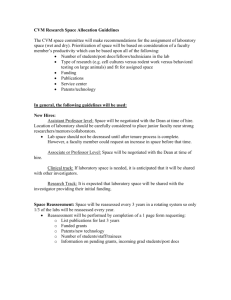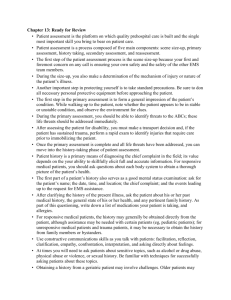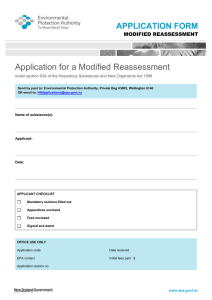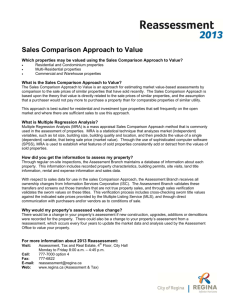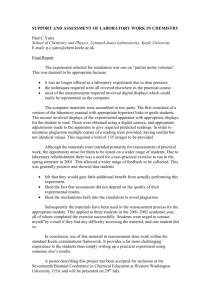ENVIRONMENTAL RISK MANAGEMENT AUTHORITY DECISION
advertisement
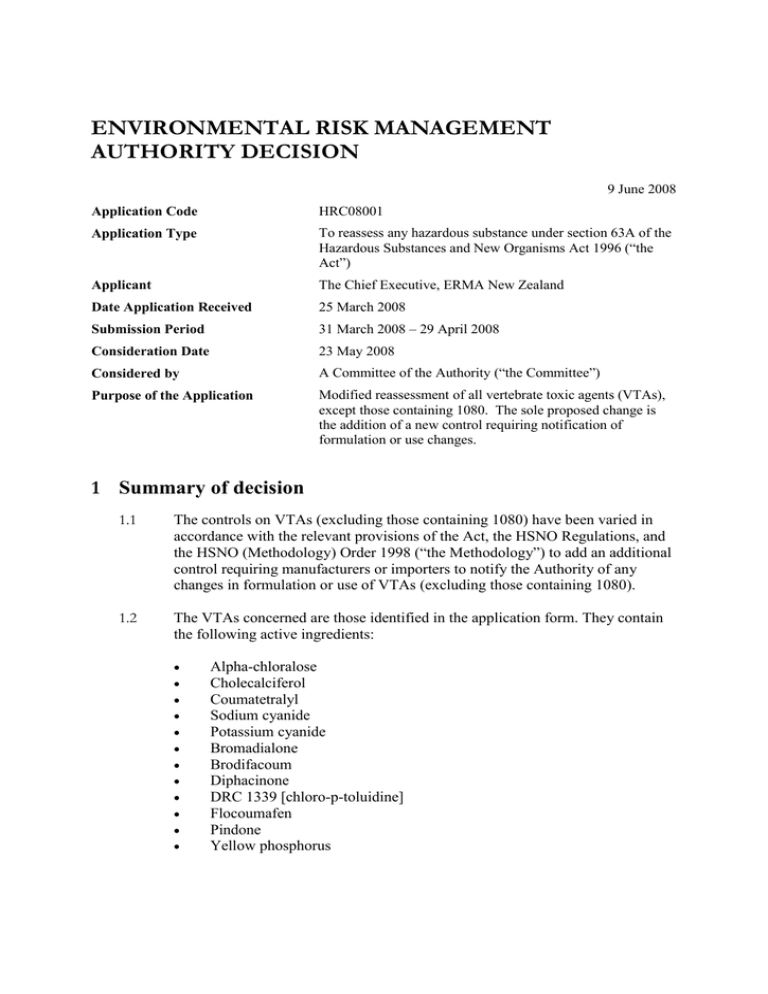
ENVIRONMENTAL RISK MANAGEMENT AUTHORITY DECISION 9 June 2008 Application Code HRC08001 Application Type To reassess any hazardous substance under section 63A of the Hazardous Substances and New Organisms Act 1996 (“the Act”) Applicant The Chief Executive, ERMA New Zealand Date Application Received 25 March 2008 Submission Period 31 March 2008 – 29 April 2008 Consideration Date 23 May 2008 Considered by A Committee of the Authority (“the Committee”) Purpose of the Application Modified reassessment of all vertebrate toxic agents (VTAs), except those containing 1080. The sole proposed change is the addition of a new control requiring notification of formulation or use changes. 1 Summary of decision 1.1 The controls on VTAs (excluding those containing 1080) have been varied in accordance with the relevant provisions of the Act, the HSNO Regulations, and the HSNO (Methodology) Order 1998 (“the Methodology”) to add an additional control requiring manufacturers or importers to notify the Authority of any changes in formulation or use of VTAs (excluding those containing 1080). 1.2 The VTAs concerned are those identified in the application form. They contain the following active ingredients: Alpha-chloralose Cholecalciferol Coumatetralyl Sodium cyanide Potassium cyanide Bromadialone Brodifacoum Diphacinone DRC 1339 [chloro-p-toluidine] Flocoumafen Pindone Yellow phosphorus 2 Legislative criteria for the application 2.1 The application was lodged by the Chief Executive pursuant to section 63A following grounds for reassessment having been established under section 62 by the Authority in its decision dated 11 February 2008. 2.2 Under section 63A, the Authority may, following a finding that there are grounds for the reassessment of a hazardous substance, conduct a modified reassessment of the substance. 2.3 According to section 63A(1), such a modified reassessment may be carried out where the Authority considers that the reassessment will involve only a specific aspect of the approval and the proposed amendment is not a minor or technical amendment to which section 67A applies. 2.4 According to section 63A(2), the Authority, as a result of a modified reassessment under section 63A, may vary the controls that attach to a hazardous substance, but may not revoke an approval given to the substance under the Act to import or manufacture the substance. 2.5 Pursuant to section 63A(6), in deciding whether to approve or decline an application for a modified reassessment, the Authority must take into account all the effects associated with the reassessment proposal and the best international practices and standards for the safe management of the substance. 2.6 This reassessment decision was determined in accordance with section 63A, taking into account matters to be considered in that section and matters specified under Part II of the Act. Unless otherwise stated, references to section numbers in this decision refer to sections of the Act. 2.7 Consideration of the application also followed the relevant provisions of the Methodology. Unless otherwise stated, references to clauses in this decision refer to clauses of the Methodology. 3 Application process 3.1 The application was formally received on 25 March 2008. 3.2 Section 63A(4) allows the Authority to reassess substances under section 63A without publicly notifying the reassessment in accordance with section 53, providing the Authority does everything reasonably practicable on its part to consult with all persons who, in its opinion, may be affected by the reassessment (section 63A(5)). 3.3 In its decision on the ‘grounds’ application, the Authority was of the view that ‘affected parties’ consultation, as opposed to ‘public notification’ was appropriate in this case. ERMA New Zealand Decision: Application HRC08001 Page 2 of 10 3.4 In accordance with section 63A(5), manufacturers of VTAs, the Ministry of Health, the ACVM Group of the New Zealand Food Safety Authority and the Department of Labour were notified on 31 March 2008 and provided with an opportunity to make submissions or comments. 3.5 Submissions closed on 29 April 2008. 3.6 No submissions were received. Comments were received from the Ministry of Health indicating their support for the addition of the new control. 3.7 No external experts were used in the consideration of this application (clause 17). 3.8 The following members of the Authority’s Hearings Committee considered the application (under delegation under section 19(2)(b)): Ms Helen Atkins (Chair) Dr Max Suckling and Dr Deborah Read. 3.9 The information available to the Committee comprised: the application. a memorandum from the Agency advising them that there were no submissions and one comment in support of the application. 4 Consideration Purpose of the application 4.1 To add an additional control to VTAs (excluding those containing 1080) requiring manufacturers and importers to notify the Authority of any changes in formulation or use of those VTAs. Sequence of the consideration 4.2 In accordance with clause 24, the approach to the consideration adopted by the Committee was to: consider the proposed additional control. identify and assess the effects associated with the proposal to vary the controls (the addition of the new control) that attach to VTAs (excluding those containing 1080). identify and assess best international practices and standards for the safe management of VTAs. undertake an overall evaluation of the risks, costs, and benefits. consider whether to approve the additional control. The requirements of section 63A 4.3 According to section 63A(1), a modified reassessment may be carried out where the Authority considers that the reassessment will involve only a specific aspect of the approval and the proposed amendment is not a minor or technical amendment to which section 67A applies. ERMA New Zealand Decision: Application HRC08001 Page 3 of 10 4.4 As effects relating to the changes to the formulation of VTAs may be more than minor, the Committee is satisfied that the amendment proposal could not be considered as a minor or technical amendment to which section 67A applies. 4.5 Further, as the reassessment only relates to a specific aspect of the approval of VTAs, namely the addition of a control requiring notification of changes to formulations or use of VTAs, the Committee is satisfied that it can properly be considered under section 63A. Proposed additional control 4.6 The wording of the proposed new control is as follows: Notification of changes of composition Any changes to the composition or proposed use of [insert name of VTA] must be notified to the Authority in writing before the substance is used. The notification should include the following information, as applicable: the name of substance and HSNO approval number; details of the original formulation; details of the revised formulation clearly identifying the changed ingredients, their function in the bait, and their concentration and CAS number if appropriate; the physical form, if different from the original; bait colour; changes in bait size; the intended use(s) of the substance (to include target species, method(s) of release); change in food bait where the substance requires mixing with bait prior to use; the physical properties of the substance (for example, flashpoint, pH) if different from the original; the impurity profile and source of the ‘active’ ingredient, if different from the original; any information on the effect that the formulation change may have on the risk profile of the substance, including the results of any palatability or field trials undertaken on both target and non-target species. 4.7 The effect of this proposal is that manufacturers or importers of VTAs (excluding those containing 1080) will be required to notify the Authority of any changes in formulation or use before the substances are used. ERMA New Zealand Decision: Application HRC08001 Page 4 of 10 Identification of the effects associated with the proposal. 4.8 This control was added to formulated substances containing 1080 as a result of the reassessment by the Authority of those substances in 2007. 4.9 The Committee identified the following effects associated with addition of the proposed control: it ensures consistency of regulatory approach for all VTAs; changes in risk profile due to changes in formulation and other matters such as bait size will be able to be addressed. Each of the current HSNO substance descriptions can cover a variety of formulations. Changes to a formulation may conform to the substance description, but still affect the substance’s risk profile. For example, changes to non-hazardous components can affect palatability of a bait and hence the potential exposure of non-target organisms. Depending on the nature and extent of the formulation/bait changes, it may be necessary for the approval to be amended (or a new approval obtained) before the substance may lawfully be used. there are no new risks to the environment, human health and safety, Maori cultural and spiritual values, society and community or the market economy. Assessment of effects Assessment of risks associated with the reassessment proposal 4.10 The Committee notes that there are no risks associated with the proposal. Assessment of costs associated with the reassessment proposal 4.11 The Committee notes that any costs associated with the addition of this control accrue to the manufacturers and users of the substances. They are financial in nature, and can be considered as private costs. No quantitative analysis of the costs of the proposed control was undertaken. However, during consultation on the grounds for reassessment, two of the four manufacturers who responded indicated that the proposal was “largely common sense” and already required by the New Zealand Food Safety Authority to enable that agency to manage risks under their legislation. 4.12 One manufacturer who commented on the grounds for reassessment considered that the proposal was in effect a duplication of regulatory oversight as the NZFSA already required this information. 4.13 The other manufacturer did not comment on the issue of potential costs of the proposal. ERMA New Zealand Decision: Application HRC08001 Page 5 of 10 Assessment of effects on Māori issues and concerns associated with the reassessment proposal 4.14 From the information provided, the Committee considers that the reassessment proposal is unlikely to have an impact on the relationship between Māori culture and their traditions with their ancestral lands, water, sites, waahi tapu, valued flora and fauna and other taonga. This is on the condition that the substances are stored and used in accordance with all relevant regulations, conditions, and any other relevant controls applying under other legislation. Assessment of benefits associated with the reassessment proposal 4.15 The Committee notes that the proposed amendment will allow better regulatory oversight of changes in formulation and use of VTAs. While it is not possible to assess the benefits associated with reduction in risks to non-target species, the Committee considers that such benefits will be potentially significant. Identification and assessment of best international practices 4.16 As required, best international practices and standards were considered in proposing the new control. 4.17 The Committee notes that in general, agencies involved in pesticide registration and approval require notification of changes to formulations of any product to ensure that any resultant change in risk is adequately managed. These include the Australian Pesticide and Veterinary Medicines Authority, the United Kingdom Pesticide Safety Directorate and the United States Environmental Protection Agency Office of Pesticide Programs. 4.18 The New Zealand Food Safety Authority also requires such notification to ensure that risks addressed by their legislation are managed. 4.19 The Committee also notes that the reassessment will have no impact with respect to New Zealand’s international obligations. 5 Conclusion 5.1 The Committee considers that there are potential benefits associated with the addition of the requirement to notify the Authority of any changes in formulation or use of VTAs. 5.2 The Committee does not consider there to be significant risks to human health, the environment, Maori cultural wellbeing, society and community, the market economy, or to New Zealand’s international obligations from the addition of the proposed control. 5.3 Accordingly, the Committee considers that the benefits of the proposal outweigh the costs. ERMA New Zealand Decision: Application HRC08001 Page 6 of 10 6 Decision 6.1 The Committee determines that: 6.1.1 the application meets the criteria for consideration under section 63A. 6.1.2 having considered all the effects associated with the reassessment proposal and best international practices and standards for the safe management of VTAs, that the controls on VTAs (excluding those containing 1080) should be varied to add the control set out in paragraph 4.6 above, to require manufactures and importers of the listed VTAs to notify the Authority of any changes in formulation or use of the substances. 6.1.3 accordingly, the additional control set out in Appendix 1 shall apply to the listed VTAs. 6.2 In accordance with clause 36(2)(b), the Committee records that, in reaching this conclusion, it has taken into account the criteria of section 63(6). 6.3 It has also applied the following criteria in the Methodology: clause 9 – equivalent of sections 5, 6 and 8; clause 11 – characteristics of substance; clause 12 – evaluation of assessment of risks; clause 13 – evaluation of assessment of costs and benefits; clause 14 – costs and benefits accruing to New Zealand; clause 21 – the decision accords with the requirements and regulations; clause 22 – the evaluation of risks, costs and benefits – relevant considerations; clause 24 – the use of recognised risk identification, assessment, evaluation and management techniques; clause 25 – the evaluation of risks; clause 26 – negligible risks; clause 33 – risk characteristics; clause 34 – the aggregation and comparison of risks, costs and benefits; and clause 35 – the costs and benefits of varying the default controls. Ms Helen Atkins Chair ERMA New Zealand Decision: Application HRC08001 Date: 9 June 2008 Page 7 of 10 ERMA New Zealand Approval Codes: Bait containing 0.02 g/kg brodifacoum (Reassessed HRC08001) HRC000004 Bait containing 0.05 g/kg - 0.1 g/kg bromadiolone (Reassessed - HRC08001) HRC000005 Bait containing 0.05 g/kg brodifacoum (Reassessed HRC08001) HRC000006 Bait containing 0.05 g/kg diphacinone (Reassessed HRC08001) HRC000007 Bait containing 0.05 g/kg flocoumafen (Reassessment HRC08001) HRC000008 Bait containing 0.25 - 0.5 g/kg pindone (Reassessment - HRC08001) HRC000009 Bait containing 0.375 - 0.5 g/kg coumatetralyl (Reassessed - HRC08001) HRC000010 Bait containing 0.55 - 1.84 % w/w encapsulated potassium cyanide (Reassessed - HRC08001) HRC000011 Bait containing 8 g/kg cholecalciferol (Substance A) (Reassessed - HRC08001) HRC000012 Bait containing 8 g/kg cholecalciferol (Substance B) (Reassessed - HRC08001) HRC000013 Encapsulated paste containing 500 g/kg potassium cyanide (Reassessed - HRC08001) HRC000014 Encapsulated pellet containing 800 g/kg potassium cyanide (Reassessed - HRC08001) HRC000015 Feratox 475 g/kg (Reassessed - HRC08001) HRC000016 Paste containing 0.3 g/kg diphacinone (Reassessed HRC08001) HRC000017 Paste containing 25 g/kg alpha-chloralose (Reassessed - HRC08001) HRC000018 Paste containing 4.5 - 5 g/kg yellow phosphorus (Reassessed - HRC08001) HRC000019 ERMA New Zealand Decision: Application HRC08001 Page 8 of 10 Paste containing 500 - 600 g/kg sodium cyanide (Reassessed - HRC08001) HRC000020 Paste containing 9.5 - 10 g/kg yellow phosphorus (Reassessed - HRC08001) HRC000021 Powder containing 7.4 g/kg coumatetralyl (Reassessed -HRC08001) HRC000022 Powder containing 970 - 980 g/kg 3-chloro-p-toluidine hydrochloride (Reassessed - HRC08001) HRC000023 Solid containing 900 - 1000 g/kg alpha-chloralose (Reassessed - HRC08001) HRC000024 Soluble concentrate containing 34 g/litre pindone as the sodium salt (Reassessed - HRC08001) HRC000025 Treated seed containing 22 - 25 g/kg alpha-chloralose (Reassessed - HRC08001) HRC000026 ERMA New Zealand Decision: Application HRC08001 Page 9 of 10 APPENDIX 1: ADDITIONAL CONTROL FOR VTAS (EXCLUDING THOSE CONTAINING 1080) Notification of changes of composition Any changes to the composition or proposed use of [insert name of VTA] must be notified to the Authority in writing before the substance is used. The notification should include the following information, as applicable: the name of substance and HSNO approval number; details of the original formulation; details of the revised formulation clearly identifying the changed ingredients, their function in the bait, and their concentration and CAS number if appropriate; the physical form, if different from the original; bait colour; changes in bait size; the intended use(s) of the substance (to include target species, method(s) of release); change in food bait where the substance requires mixing with bait prior to use; the physical properties of the substance (for example, flashpoint, pH) if different from the original; the impurity profile and source of the ‘active’ ingredient, if different from the original; any information on the effect that the formulation change may have on the risk profile of the substance, including the results of any palatability or field trials undertaken on both target and non-target species. ERMA New Zealand Decision: Application HRC08001 Page 10 of 10
